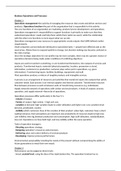Business Operations and Processes
Chapter 1
Operations management=the activity of managing the resources that create and deliver services and
products. Operations function=the part of the organization that is responsible for this activity.
The core functions of an organization are marketing, product/service development, and operations.
Operations management’s responsibility to support functions is primarily to make sure that they
understand operations’ needs and help them satisfy them (what we want), while the relationship
with the other core functions is more equal (what we can do).
Operations management uses resources to appropriately create outputs that fulfill defined market
requirements.
Small companies cannot dedicate individuals to specialized tasks -> people have different jobs as the
need arises. Allows them to respond quickly to change, but decision making may become confused as
the roles overlap.
Since the strategic objectives for non-profits may be more complex, there may be a greater chance of
operations decisions being made under conditions of conflicting objectives.
Inputs are used to transform something, or are transformed themselves, into outputs of services and
products. Transformed inputs: materials (physical properties, location, possession or store),
information, customers (co-production: customer plays active part in operations, e.g. gives
information). Transforming inputs: facilities (buildings, equipment) and staff.
Most operations produce a mixture of tangible products and intangible services.
A process is an arrangement of resources and activities that transform inputs into outputs that satisfy
customer needs. Each process is an internal supplier and internal customer. Transformed resources
flow between processes as well as between units of transforming resources (e.g. individuals).
Supply network=network of operations with similar services/products. 3 levels of analysis: process,
operation, and supply network =hierarchy of operations.
Operations processes differ particularly in the four V’s:
- volume of output.
- Variety of output: high variety -> high unit cost.
- variation in demand: high variation leads to under-utilization and higher cost. Low variation=level
demand, predictable, routine.
- visibility which customers have of the creation of their product: when high, customers have a short
waiting tolerance, their perceptions are important, low productivity of resources leads to high cost.
Low visibility: time lag between production and consumption, high staff-utilization, standardization,
low cost. Operations can have both high- and low visibility within the same operation.
Tasks of operation managers:
- Directing operations strategy.
- Designing operation’s resources and processes
- Delivering: plan and control delivery of services/products
- Developing: improve process performance.
Environmental sustainability=meeting the needs of the present without compromising the ability of
future generations to meet their own needs.
Chapter 2
Performance can be judged at three levels:
- broad, societal level, using the idea of the triple bottom line. The operation function has to
,understand the objectives of its stakeholders and set its objectives accordingly=corporate social
responsibility (CRS). Triple bottom line=measure business not just on traditional economic profit
that they generate for their owners, but also on the impact their operations have on society and the
environment.
People: social bottom line, measured by the impact of the operation on the quality of
people’s lives.
Plant: environmental bottom line.
Profit: economic bottom line, measured by profitability, return on asset, etc.
- strategic level. Operations can contribute to financial success through low cost (efficiency),
increasing revenue (quality, delivery, flexibility), lowering risk, making efficient use of capital
(productivity, lower investment), and building the capabilities for future innovation (process
knowledge).
- operational level, using the 5 operations performance objectives:
Quality: error-free products, clean, friendly. Reduces costs, irritation, and distraction.
Speed: the elapsed time between customers requesting products and their receiving them.
Availability of goods, decision making, movement of materials and information.
More likely to buy it/pay more. Reduces inventories, reduces risk: forecast demand
for only one week instead of 6.
Dependability: keeping promises, receive services exactly when needed, cancelled
appointments, schedules, availability of seats, opening hours, goods out of
stock, parking places. Customers look at dependability afterwards. Inside:
delivering material or information, more effective, saves time and money,
gives stability/predictability.
Flexibility: change far and quick enough with customer requirements. Product flexibility:
introduce new/modified products. Mix flexibility: produce wide range of
products. Volume flexibility. Delivery flexibility. Mass customization=low cost,
mass production of customized products. Flexibility in design.
Agility=responding to market requirements by producing new and existing
products fast and flexibly. Increases speed, saves time, maintains dependability.
Cost: lower prices/more profit. Productivity=output/input. Single-factor productivity=
output/one input (e.g. 1 employee, gives number of cars per employee). Input costs
may be high, but the operation itself is good at converting them to goods. Input costs
can be included in productivity if the single input factor is expressed in cost terms, e.g.
labour costs. Reduce cost by improving productivity: reduce inputs while remaining
output, or make better use of inputs (reduce waste). Reduce cost by improving other
performance objectives.
Polar representation is a useful way of representing the relative importance of performance
objectives. The closer to the origin, the less important.
Performance measurement is the process of quantifying action. Performance is assumed to derive
from actions taken by its management. Needed to judge whether improvement is being made.
Performance measurement concerns:
- what factors to include as performance measures? Measures can be aggregated into composite
measures (e.g. customer satisfaction). All factors at each level (societal/strategic/operational) can be
broken down into more detailed measures.
- which are the most important performance measures? Balance between few key measures (broad)
and many detailed measures (complex).
- what detailed measures to use?
, Balanced scorecard approach=best-known performance measurement approach, retains traditional
financial measures, tell the story of past events. Also includes operational measures. Restricted
number of measures, encourages companies to take decisions in the interest of the whole
organization rather than sub-optimizing around narrow measures.
Improving the performance of one objective might only be achieved by sacrificing performance in
another. 2 views of trade-offs: repositioning performance objectives by trading off improvements in
some objectives for a reduction in performance in others, or increase effectiveness by overcoming
trade-offs so that improvements in one or more aspects of performance can be achieved without any
reduction in the performance of others.
Operations that lie on the efficient frontier have performance levels that dominate those which do
not. Overcome trade-off (create new efficient frontier) by being flexible.
Chapter 3
Strategy=the total pattern of the decisions and actions that influence he long-term direction of the
business.
Operations is not the same as operational, it is the resources that create products and services.
Roles of operations: implementing, supporting, and driving strategy. Four stages of operations
contribution:
1. Internal neutrality=holding company back from competing effectively, intends to improve by
avoiding mistakes.
2. External neutrality=compare itself with similar companies in the outside market, implement best
practice.
3. Internally supportive=gain clear view of the company’s goals and supporting it by developing
appropriate operations resources.
4. Externally supportive=operations function provides foundation for competitive success, forecast
changes, innovative.
Different views of operations strategy:
- Top-down perspective: begin with corporate strategy decisions, like what businesses to be in and
what parts of the world. Then business units put together their own business strategy, like growth
targets. Then functional strategy decisions are made, like allocation of resources.
- Bottom-up perspective/emergent strategies: strategic ideas emerge over time from operational
experience. No high-level decision making, but general consensus.
- Market requirement perspective: whatever competitive factors are important to customers should
influence the priority if each performance objective. Order-winning factors are those things which
directly and significantly contribute to winning business, key reasons to buy the product. Raising
performance in an order-winning factor will either result in more business or improve the chances of
gaining more business. Qualifying factors: operation’s performance has to be above a particular level
just to be considered by customers. Improvement above the qualifying level is unlikely to gain
competitive benefit. Less important factors do not influence customers in any significant way.
The product/service life cycle influence on performance objectives:
Introduction stage: something new, few competitors, needs of customers are not well
understood -> need to be flexible and have quality.
Growth stage: competitors enter, volume grows, keep up with demand -> speed,
dependability, quality (don’t lose to competitors)
Maturity stage: demand starts to level off, competitors may have left, few large companies
dominate, cut cost, dependable supply.
Decline stage: compete on price.






